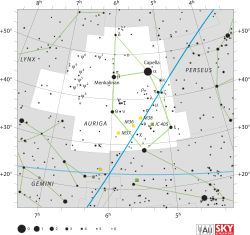HD 36891
| HD 36891 | |
 | |
| Observationsdata Epok: J2000.0 | |
|---|---|
| Stjärnbild | Kusken |
| Rektascension | 05t 36m 52,41522 s[1] |
| Deklination | +40° 10′ 56,5783″[1] |
| Skenbar magnitud () | +6,08 ± 0,009 (v)[2] |
| Stjärntyp | |
| Spektraltyp | G3 Ib[3] + B7 V? [4] |
| U–B | +0,69[2] |
| B–V | +1,03[2] |
| Astrometri | |
| Radialhastighet () | -12,06 ± 0,03[4] km/s |
| Egenrörelse (µ) | RA: -2,99 ± 1,03[5] mas/år Dek.: -4,56 ± 0,67[5] mas/år |
| Parallax () | 1,9414 ± 0,0574[1] |
| Avstånd | 1 680 ± 50 lå (520 ± 20 pc) |
| Absolut magnitud () | -2,79[6] |
| Detaljer | |
| Radie | 45,78+2,89-3,69[1] R☉ |
| Luminositet | 1 094 ± 43[1] L☉ |
| Temperatur | 4 907+210-149[1] K |
| Metallicitet | +0,04 (Fe/H)[7] dex |
| Vinkelhastighet | 6,2[8] km/s |
| Andra beteckningar | |
| AG+40 652, AKARI-IRC-V1, J0536525+401056, BD+40 1346, GSC 02914-00924, HIC 26363, HIP 26363, HR 1884, IRAS 05334+4009, 2MASS J05365242+4010565, PPM 48282, SAO 40481, TYC 2914-924-1, uvby98 100036891, Gaia DR2 191167349376886016, Gaia EDR3 191167349378062592 [9] | |
HD 36891 ( eller HR 1884) är en dubbelstjärna i den mellersta delen av stjärnbilden Kusken. Den har en kombinerad skenbar magnitud av ca 6,08[2] och är mycket svagt synlig för blotta ögat där ljusföroreningar ej förekommer. Baserat på parallax enligt Gaia Data Release 2 på ca 1,9[1] mas, beräknas den befinna sig på ett avstånd på ca 1 680 ljusår (ca 520 parsek) från solen. Den rör sig närmare solen med en heliocentrisk radialhastighet på ca -12 km/s.[4]
Egenskaper
Primärstjärnan HD 36891 A är en gul till vit superjättestjärna av spektralklass G3 Ib.[3] Den har en radie som är ca 46[1] solradier och har ca 1 100 gånger solens utstrålning av energi[1] från dess fotosfär vid en effektiv temperatur av ca 4 900 K.[7]
Stjärnans möjliga karaktär av spektroskopisk dubbelstjärna noterades första gången 1983 av Gilbert Burki och Michel Mayor i en artikel om graden av dubbelstjärnor bland superjättar.[10] Samma år noterade William P. Bidelman att stjärnans spektrum var sammansatt vilket tyder på en följeslagare.[11] Bekräftelse av spektroskopisk dubbelstjärna och en preliminär omloppsbana publicerades 1998 av R. Paul Butler.[12] En mycket mer exakt omloppsbana med en omloppsperiod på ca 7 830 dygn och en excentricitet på 0,8867 publicerades 2015 av Roger Griffin.[4] Följeslagaren är en stjärna i huvudserien av spektralklass B7 V?.[4]
Referenser
- Den här artikeln är helt eller delvis baserad på material från engelskspråkiga Wikipedia, HR 1884, 27 mars 2022.
Noter
- ^ [a b c d e f g h i] Brown, A. G. A.; et al. (Gaia collaboration) (August 2018). "Gaia Data Release 2: Summary of the contents and survey properties". Astronomy & Astrophysics. 616. A1. arXiv:1804.09365. Bibcode:2018A&A...616A...1G. doi:10.1051/0004-6361/201833051. Gaia DR2 record for this source at VizieR.
- ^ [a b c d] Argue, A. N. (1966). "UBV photometry of 550 F, G and K type stars". Monthly Notices of the Royal Astronomical Society. 133 (4): 175–493. Bibcode:1966MNRAS.133..475A. doi:10.1093/mnras/133.4.475.
- ^ [a b] Bidelman, William P. (1957). "Spectral Classification of Stars Noted on Case Objective-Prism Plates. I". Publications of the Astronomical Society of the Pacific. 69 (407): 147–152. Bibcode:1957PASP...69..147B. doi:10.1086/127034.
- ^ [a b c d e] Griffin, R. F. (2015). "Spectroscopic binary orbits from photoelectric radial velocities. Paper 241: HR 1884, HD 174103, HD 182563, and HR 8442, with a note on zeta Cephei". The Observatory. 135: 71–95. Bibcode:2015Obs...135...71G.
- ^ [a b] van Leeuwen, F. (2007). "Validation of the new Hipparcos reduction". Astronomy and Astrophysics. 474 (2): 653–664. arXiv:0708.1752. Bibcode:2007A&A...474..653V. doi:10.1051/0004-6361:20078357. S2CID 18759600. Vizier catalog entry
- ^ Kovtyukh, V. V.; Chekhonadskikh, F. A.; Luck, R. E.; Soubiran, C.; Yasinskaya, M. P.; Belik, S. I. (2010). "Accurate luminosities for F-G supergiants from FeII/FeI line depth ratios". Monthly Notices of the Royal Astronomical Society. 408 (3): 1568. Bibcode:2010MNRAS.408.1568K. doi:10.1111/j.1365-2966.2010.17217.x.
- ^ [a b] Luck, R. Earle (2014). "Parameters and Abundances in Luminous Stars". The Astronomical Journal. 147 (6): 137. Bibcode:2014AJ....147..137L. doi:10.1088/0004-6256/147/6/137.
- ^ De Medeiros, J. R.; Udry, S.; Burki, G.; Mayor, M. (2002). "A catalog of rotational and radial velocities for evolved stars. II. Ib supergiant stars". Astronomy and Astrophysics. 395: 97–98. Bibcode:2002A&A...395...97D. doi:10.1051/0004-6361:20021214.
- ^ HD 36891 (unistra.fr) |Hämtad 2022-05-17.
- ^ Burki, G.; Mayor, M. (1983). "Nineteen new spectroscopic binaries and the rate of binary stars among F-M supergiants". Astronomy and Astrophysics. 124 (2): 256–266. Bibcode:1983A&A...124..256B.
- ^ Bidelman, W. P. (1983). "Objective-prism discoveries in the northern sky. I". Astronomical Journal. 88: 1182–1186. Bibcode:1983AJ.....88.1182B. doi:10.1086/113408.
- ^ Butler, R. Paul (1998). "A Precision Velocity Study of Photometrically Stable Stars in the Cepheid Instability Strip". Astrophysical Journal. 494 (1): 342–365. Bibcode:1998ApJ...494..342B. CiteSeerX 10.1.1.37.7095. doi:10.1086/305195.
Externa länkar
- https://www.universeguide.com/star/26363/hip26363.















